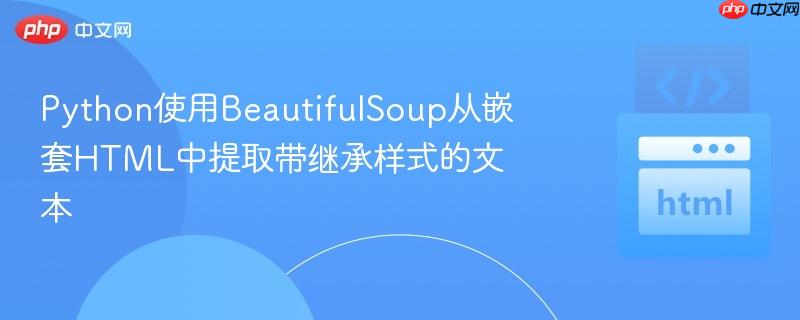
在处理复杂的html结构时,尤其是当标签存在嵌套关系且样式可以通过css继承时,准确地获取每个文本片段的最终样式是一个常见的挑战。例如,一个<span>标签内的文本可能继承了其父级<span>标签的样式,同时又拥有自己的特定样式。传统的beautifulsoup解析方法可能难以直接捕获这种继承关系,导致难以获取每个独立文本块的完整样式信息。
解决此问题的关键在于采用递归解析方法,并显式地处理样式继承。BeautifulSoup库提供了children属性,可以方便地遍历一个HTML元素的直接子节点,这些子节点可以是纯文本(NavigableString类型)或子标签(Tag类型)。
我们的策略是:
通过这种方式,每个文本片段都能获得其所在上下文环境下的最终计算样式。
我们将创建一个名为get_as_list的递归函数,它接收一个BeautifulSoup对象(通常是Tag类型)和一个可选的外部样式字典(extstyle),用于传递父级继承的样式。
立即学习“Python免费学习笔记(深入)”;
import bs4
from bs4 import BeautifulSoup, NavigableString, Tag
def get_as_list(obj, extstyle=None):
"""
递归函数,用于从HTML元素中提取文本及其继承的样式。
参数:
obj (bs4.element.Tag): 当前要处理的BeautifulSoup标签对象。
extstyle (dict, optional): 从父级元素继承的样式字典。
返回:
list: 包含字典的列表,每个字典包含'text'和'styles'。
"""
alldata = []
# 初始化当前元素的样式字典,包含需要关注的样式属性
# 默认值为None,表示未指定
current_style = {
"color": None,
"font-weight": None,
"font-style": None,
"text-decoration": None
}
# 如果有外部继承样式,则先应用外部样式
if extstyle is not None:
current_style.update(extstyle) # 使用update合并,确保继承的优先级
# 解析当前元素的style属性,并更新样式字典
if 'style' in obj.attrs:
# obj.attrs['style'] 示例: 'color: #55FF55; font-weight: bold;'
style_str = obj.attrs['style']
# 简单地按分号分割,然后按冒号分割键值对
for part in style_str.split(';'):
part = part.strip()
if part:
try:
key, value = part.split(':', 1) # 只分割第一个冒号
key = key.strip()
value = value.strip()
if key in current_style: # 只更新我们关心的样式
current_style[key] = value
except ValueError:
# 忽略格式不正确的样式声明
pass
# 遍历当前元素的所有子节点
for x in obj.children:
if isinstance(x, NavigableString):
# 如果是纯文本节点,将其文本和当前计算的样式添加到结果列表
text_content = str(x).strip()
if text_content: # 仅添加非空文本
alldata.append({'text': text_content, 'styles': current_style.copy()})
# 使用.copy()确保每个文本片段都有独立的样式字典副本
elif isinstance(x, Tag):
# 如果是子标签,递归调用get_as_list,并将当前样式作为extstyle传递
alldata.extend(get_as_list(x, current_style))
return alldata
下面是一个完整的示例,展示如何使用上述get_as_list函数来解析一个包含嵌套<span>标签的HTML字符串。
import bs4
from bs4 import BeautifulSoup, NavigableString, Tag
# 定义上述的 get_as_list 函数
def get_as_list(obj, extstyle=None):
alldata = []
current_style = {
"color": None,
"font-weight": None,
"font-style": None,
"text-decoration": None
}
if extstyle is not None:
current_style.update(extstyle)
if 'style' in obj.attrs:
style_str = obj.attrs['style']
for part in style_str.split(';'):
part = part.strip()
if part:
try:
key, value = part.split(':', 1)
key = key.strip()
value = value.strip()
if key in current_style:
current_style[key] = value
except ValueError:
pass
for x in obj.children:
if isinstance(x, NavigableString):
text_content = str(x).strip()
if text_content:
alldata.append({'text': text_content, 'styles': current_style.copy()})
elif isinstance(x, Tag):
alldata.extend(get_as_list(x, current_style))
return alldata
# 示例HTML字符串
html_string = """Normal<span style="font-weight: bold;">Bold <span style="font-style: italic;">BoldAndItalic</span></span><span style="font-style: italic;">Italic</span>"""
# 使用BeautifulSoup解析HTML
soup = BeautifulSoup(html_string, 'html.parser')
final_output = []
# 定义默认样式,用于顶级文本节点
default_styles = {
"color": None,
"font-weight": None,
"font-style": None,
"text-decoration": None
}
# 遍历soup的直接内容(包括文本和标签)
for element in soup.contents:
if isinstance(element, NavigableString):
# 处理顶级纯文本节点
text_content = str(element).strip()
if text_content:
final_output.append({'text': text_content, 'styles': default_styles.copy()})
elif isinstance(element, Tag):
# 处理顶级标签节点,传入默认样式作为初始继承样式
final_output.extend(get_as_list(element, default_styles))
# 打印结果
import json
print(json.dumps(final_output, indent=2, ensure_ascii=False))
输出结果:
[
{
"text": "Normal",
"styles": {
"color": null,
"font-weight": null,
"font-style": null,
"text-decoration": null
}
},
{
"text": "Bold",
"styles": {
"color": null,
"font-weight": "bold",
"font-style": null,
"text-decoration": null
}
},
{
"text": " ",
"styles": {
"color": null,
"font-weight": "bold",
"font-style": null,
"text-decoration": null
}
},
{
"text": "BoldAndItalic",
"styles": {
"color": null,
"font-weight": "bold",
"font-style": "italic",
"text-decoration": null
}
},
{
"text": "Italic",
"styles": {
"color": null,
"font-weight": null,
"font-style": "italic",
"text-decoration": null
}
}
]通过结合BeautifulSoup的DOM遍历能力和递归函数的样式传递机制,我们能够有效地从复杂的、包含嵌套标签的HTML字符串中,提取出每个独立文本片段及其准确的计算样式。这种方法对于需要对HTML内容进行精细化分析、转换或重新渲染的场景非常有用,例如内容管理系统、富文本编辑器或数据抓取后的清洗工作。通过灵活调整get_as_list函数中的样式解析逻辑和关注的样式属性,可以适应更广泛的需求。
以上就是Python使用BeautifulSoup从嵌套HTML中提取带继承样式的文本的详细内容,更多请关注php中文网其它相关文章!

HTML怎么学习?HTML怎么入门?HTML在哪学?HTML怎么学才快?不用担心,这里为大家提供了HTML速学教程(入门课程),有需要的小伙伴保存下载就能学习啦!

Copyright 2014-2025 https://www.php.cn/ All Rights Reserved | php.cn | 湘ICP备2023035733号